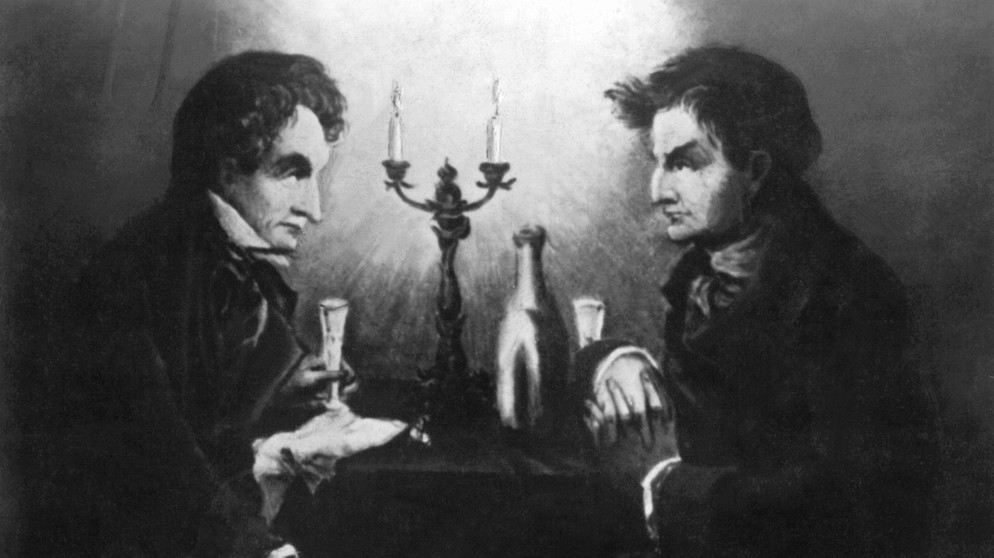Thanks to him, Freud discovered the unconscious: Who is Ernst Theodor Amadeus Hoffmann?
It is said that Freud would not have discovered the unconscious if Hoffmann had not written "The Sandman" in his short story collection The Night Paintings.

Ernst Theodor Amadeus Hoffmann was born on January 24, 1776 in Königsberg, East Prussia, Kingdom of Prussia.
He is a German writer of fantasy and fiction stories during the Romantic era, as well as a jury member, composer, music critic, illustrator, and cartoonist.
Born in Kaliningrad, Prussia, Hoffmann's stories found much interest in the 19th century, and became one of the important writers of the Romanticism movement.
Ernst Theodor Amadeus Hoffmann (born Ernst Theodor Wilhelm Hoffmann; 24 January 1776 – 25 June 1822) was a German Romantic author of fantasy and Gothic horror, a jurist, composer, music critic and artist. His stories form the basis of Jacques Offenbach's opera The Tales of Hoffmann, in which Hoffmann appears (heavily fictionalized) as the hero.
Ernst Theodor Amadeus Hoffmann continued to write stories until his death in Berlin in 1882. He died on 25 June 1822 in Berlin, Brandenburg, Kingdom of Prussia.
Life story
He was born on August 24, 1776, in Königsberg (present-day Kaliningrad) in East Prussia. His father, Christoph Ludwig Hoffmann, was a lawyer; His mother, Louisa Albertina Doerffer, came from a well-established family.
He is also the author of the novella The Nutcracker and the Mouse King, on which Pyotr Ilyich Tchaikovsky's ballet The Nutcracker is based. The ballet Coppélia is based on two other stories that Hoffmann wrote, while Schumann's Kreisleriana is based on Hoffmann's character Johannes Kreisler. Hoffmann's stories highly influenced 19th-century literature, and he is one of the major authors of the Romantic movement.
His parents divorced when Hoffmann was two, and Louisa returned to her parent's home with her son. Hoffmann grew up in this house with his uncles and aunts. After graduating from the Burgschule, where he studied music, literature, and painting, he studied law at the University of Königsberg.
After graduating in 1795, he became a lawyer; He practiced his profession in Königsberg, Glogau, and Berlin. In 1800, he was appointed to the court in Poznan, a Polish province. He was engaged to his cousin Minna Doerffer, but four years later he broke the engagement and married Michalina Rorer. For a time he was exiled to the town of Plock for drawing and distributing caricatures of Poznan's leading figures, then in 1804, he was assigned to Warsaw. This year, he changed his name from "Wilhelm" to "Amadeus" from his love of Mozart.
In 1805, a daughter named Cäcilie was born, but meanwhile, Hoffmann's life was turned upside down: French armies occupied Warsaw, and all government officials who did not swear loyalty to Napoleon were dismissed. Hoffmann was one of them. He sent his wife to Poznan to live with his relatives, settled in Berlin, and started his music career. Napoleon occupied Berlin, this time. Meanwhile, he learned that his daughter had died at the age of two. He moved with his wife to Bamberg, where he conducted an orchestra; Later, he was promoted to assistant manager, dealing with composition and set design.
He was appointed to Dresden as the conductor of the orchestra. His first published literary work was a collection of short stories called Fantasiestücke in Callots Manier (Dream Paintings in the Callot Style, 1814). Later, Elixir of the Devil (1815) and Paintings of the Night (1816) were published.
Appointed to a committee that investigates and brings dissidents to justice; He wrote a parody of his activities, which this committee did not approve of, in the “Knarrpanti” scene of Meister Floh (Bit Efendi). He published his compilation Serapionsbrüder (Serapion Brothers, 1819), Prinzessin Brambilla (Princess Brambilla, 1820), and Murr the Cat's World View (1820), in the last years of his life. Due to the objectionable “Knarrpanti” scene, the manuscripts of the Meister Floh book were confiscated, and Hoffmann was investigated. Meanwhile, Hoffmann's health deteriorated; When the author could only defend himself from his sickbed, the charges were discontinued.
In the end, these objectionable parts of the book were removed and published. Hoffmann died of syphilis on June 25, 1822. He was buried in the Jerusalemkirche and Deutscher Dom Community Cemetery in Berlin's Kreuzberg district. Since the name “Amadeus” was not formalized, his name is mentioned on the tombstone as ETW Hoffmann. It is said that Freud would not have discovered the unconscious if Hoffmann had not written "The Sandman" in his short story collection The Night Paintings.
-----------------------------------------
The Sandman: tale of madness and trauma still haunts, 200 years on
https://www.theguardian.com/books/2016/nov/30/the-sandman-tale-of-madness-and-trauma-still-haunts-200-years-on
